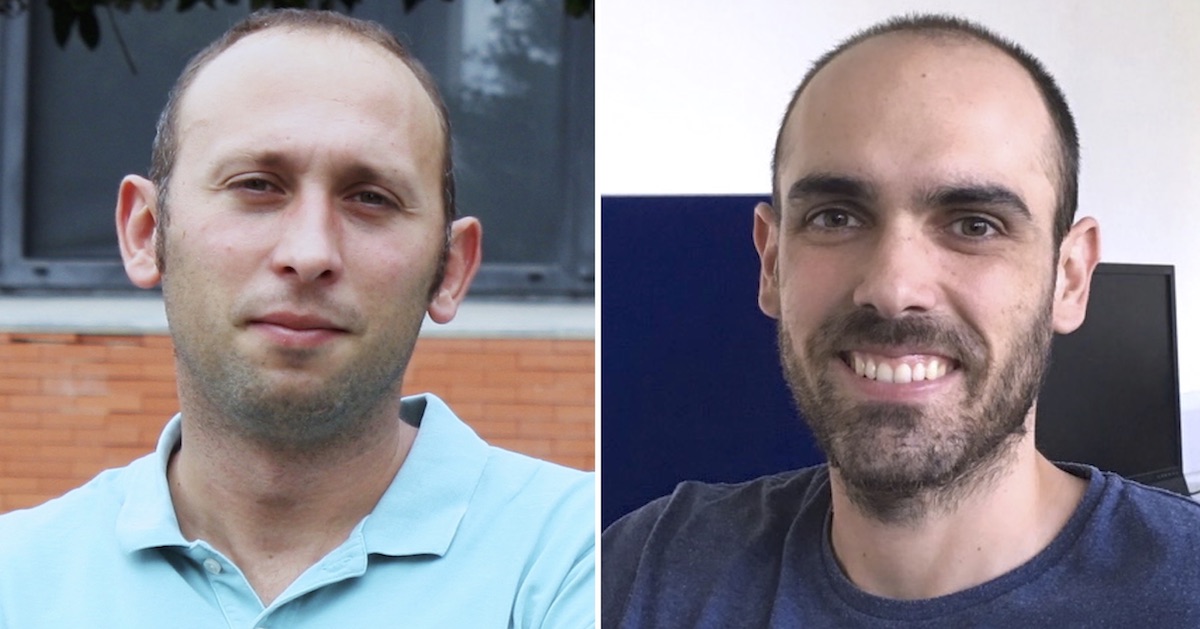Alejandro Molina (left) and Mauro Brotons
Researchers from the Institute of Materials Science of the University of Valencia (ICMUV) have contributed to detecting excitons – particles responsible for the interaction between light and matter – trapped in 2D materials that form moire patterns, one of the scientific challenges in this field. The finding, published in Nature Materials, represents a step forward towards the design of new materials for the next generation of devices applicable to the quantum computer.
In recent years, there has been a growing interest in finding alternatives to the use of the electron in the transport of information, with the aim of increasing the efficiency of the devices. For example, spintronics is based on the study of spin – the magnetic moment of the electron – as a substitute for the electron. More recently, the arrival of 2D materials such as graphene or semiconductors such as transition metal dicalcogenides has opened the possibility of using other particles, such as the exciton, formed by an electron-hole pair and without electrical charge, with great potential for quantum computing.
Excitons have extraordinary properties; they exist in semiconductor materials and their properties are especially relevant in 2D materials, only a few atoms thick. Specifically, they can store spin information and be optically manipulated by using lasers. Identifying them is important to advance the use of 2D materials in new optoelectronic applications.
Alejandro Molina, Ramón y Cajal researcher at the ICMUV’s Optoelectronic Materials and Devices unit, has contributed theory and simulations, carried out in the Tirant supercomputer of the University of Valencia, to detect the so-called ‘interlayer excitons’, which are trapped by the interaction of two sheets of transition metal dicalcogenide (TMD) atoms, and which stacked with a small twist form a moire pattern (*1).
Moire patterns affect the properties of materials and give rise to a new quantum material with properties completely different from those of its components. Obtaining controlled moiré patterns and identifying them is a scientific challenge, as their ability to obtain extraordinary properties makes this physical phenomenon a rich toolbox for optoelectronics.
“Excitons trapped in atomic moire patterns hold great promise for the design of new quantum materials, and research on their fundamental properties is crucial for future developments in this field”, explain Mauro Brotons-Gisbert and Brian D. Gerardot, researchers at the Quantum Photonics Laboratory at Heriot-Watt University (Edinburgh, UK) and main researchers of the project.
“Understanding the new physical properties in moire patterns is a new challenge for Materials Science, and theoretical and simulation work is essential here”, adds Alejandro Molina.
The study published in Nature Materials helps to understand the properties of excitons linked to moire patterns. Exciton spin control is useful for applications that combine photonics and spintronics, such as making and controlling qubits –the basic information unit of the quantum computer – using optical means.
(*1) Moiré is a geometric distortion effect caused by the interference of two weave patterns, one above the other. The result is a new pattern with a periodicity greater than that of the individual patterns that form it, and which gives rise to a singular visual effect. The name was borrowed from the French term moiré, which refers to a type of silk fabric that has a similar visual effect due to its composition based on line patterns.
Article:
Spin–layer locking of interlayer excitons trapped in moiré potentials. Mauro Brotons-Gisbert,Hyeonjun Baek, Alejandro Molina-Sánchez, Aidan Campbell, Eleanor Scerri, Daniel White, Kenji Watanabe, Takashi Taniguchi, Cristian Bonato & Brian D. Gerardot. Nature Materials.https://www.nature.com/articles/s41563-020-0687-7


